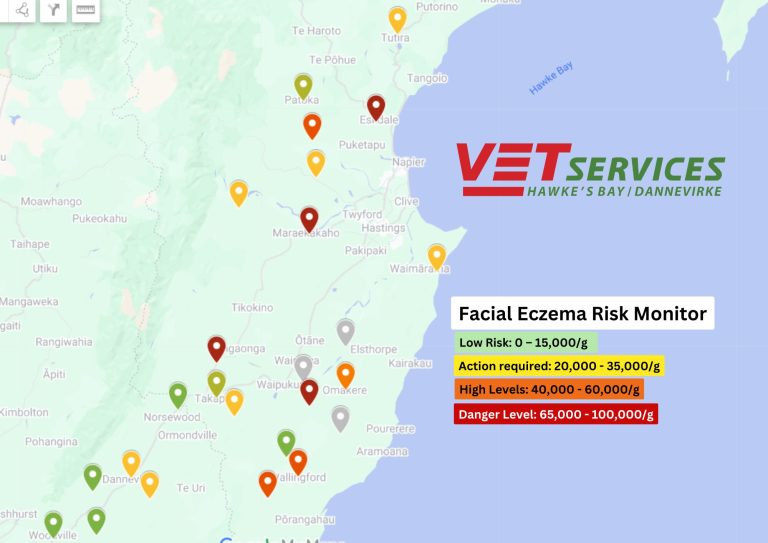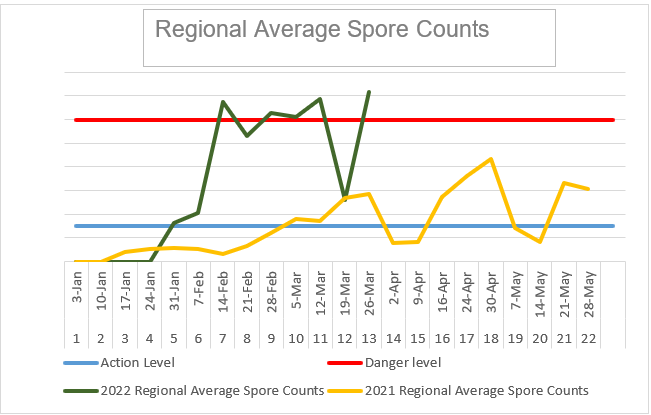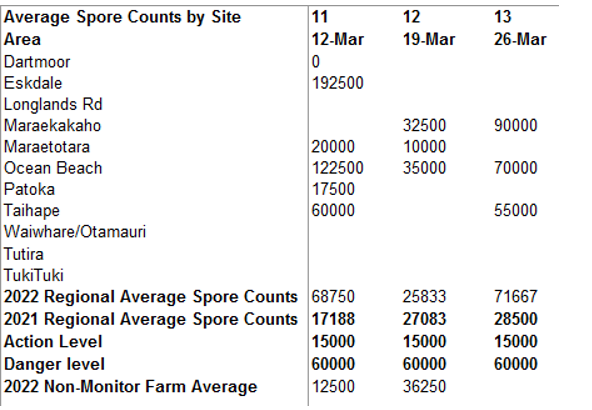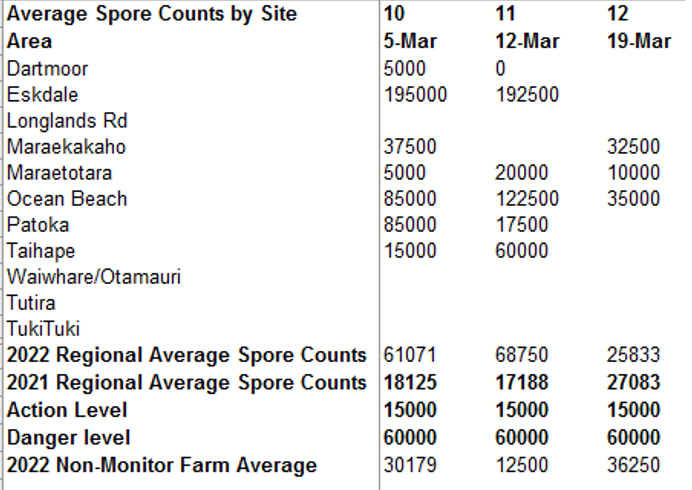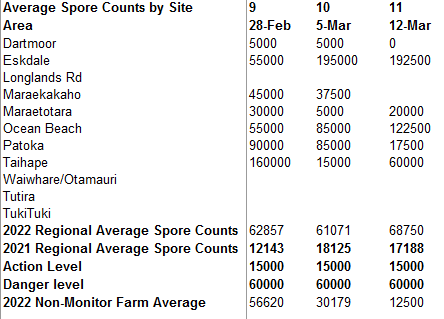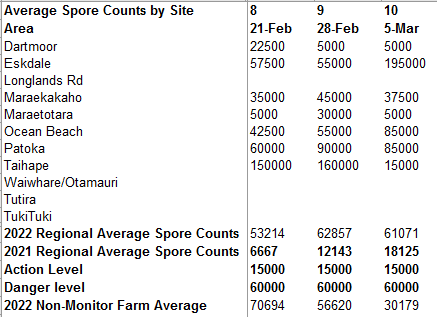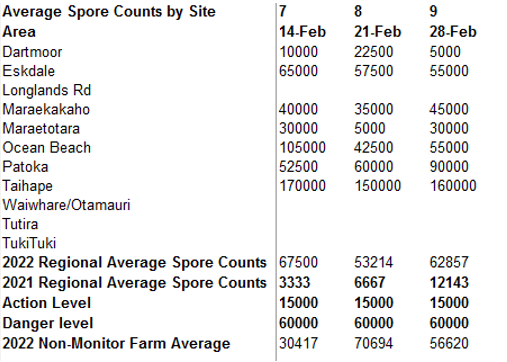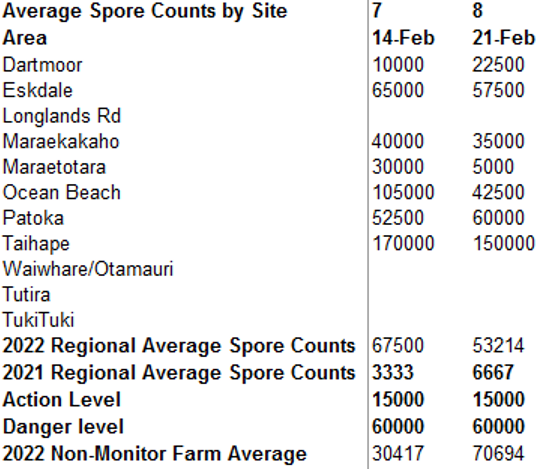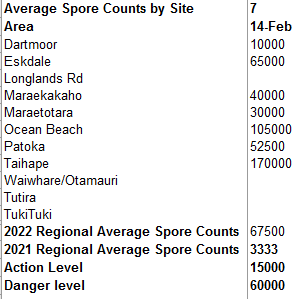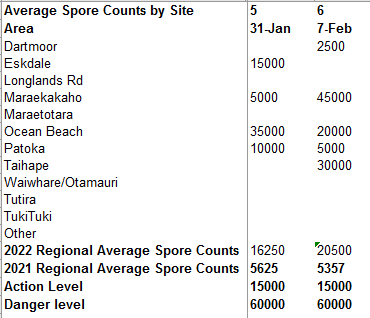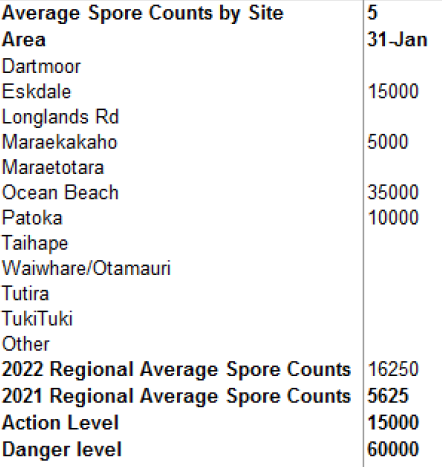Facial Eczema Risk Monitor
Vet Services weekly summary of spore counts monitoring the facial eczema risk to stock across the region
Facial Eczema risk monitor 2025


Hastings 9th May
Hot spot paddocks are reaching over 200,000spg in areas such as Glengarry, Rissington, State Highway 5 and Taihape Road. We are seeing very serious cases of clinical outbreaks of facial eczema. Clinical signs can include ill-thrift, swollen eyes, peeling skin, shade seeking, and head shaking. It is important to monitor your animals closely so that the affected can be treated early. Please call us if you are seeing signs of facial eczema so we can help with treatment options including drenching of zinc supplementation and supportive care.
Waipukurau 7th – 13th April
Farm Road is our hot spot this week, with a spore count of 140,000 epg!
Remember that spore counts of 40,000 and above are considered dangerous. There can be considerable variation between farms and even paddocks, so we recommend bringing in grass samples if you have any concerns.
Keep an eye out on our website for the latest facial eczema results, and if you have any questions, please give our clinic a call.
Hastings 7th April – 13th April
Spore counts are high this week after many warm nights. Our average FE count is 46,875 spg. There are clinical cases popping up with some hot spots around Maraekakaho (spiking at over 100,000). Clinical signs can include ill-thrift, swollen eyes, peeling skin, shade seeking and head shaking. Please give us a call if you are seeing any clinical cases. Remember clinical cases are just the tip of the iceberg and as a large number of animals are still affected sub-clinically these can lead to significant production loss long term.
Waipukurau 31 March – 6th April
Spore counts across the region are at a moderate to high risk level this week. These counts require action.
Make sure you review your options for managing facial eczema, and if you have any questions please give our clinic a call.
Waipukurau 24-30 March
An extremely high spore count again this week in Ashley Clinton, with a spore count of over 420,000/g!
Another hot spot was Farm Road, with a spore count of 100,000/g.
If you are worried about any paddocks, we recommend getting your grass samples tested so you can better manage grazing and avoid high-risk areas.
Keep an eye out on our website for the latest facial eczema results, and if you have any concerns please give our clinic a call.
Waipukurau 4 – 9 March
Ashley Clinton is still our hot spot this week, with a spore count of 50,000/g. All other areas in the region are generally seeing low counts.
As we move into autumn, if these cooler mornings continue we should start to see a drop in soil temperatures and therefore a reduced survival of spores. However we still recommend monitoring any sheltered areas or paddocks of concern.
Keep an eye out on our website for the latest facial eczema results, and if you have any concerns please give our clinic a call.
Waipukurau 24 Feb – 3 Mar
Don’t get caught off guard with Facial Eczema this season!
There is a hot spot in Ashley Clinton this week, with a dangerously high spore count of 130,000 epg!
The region is slightly greener after the recent rain and there is plenty of dead matter around. This is providing the perfect environment for spores to sporulate. So although counts in other areas may be low to moderate, we are expecting counts to continue to rise and things can change very quickly!
Please get your orders for preventative facial eczema treatment in as early as possible to avoid potential supply chain delays.
Keep an eye out on our website for the latest facial eczema results, and if you have any concerns please give our clinic a call.
Hastings 24 Feb – 3 March
Spore counts are on the rise with this weeks average pushing up to 24,166spg- moderate risk. These counts require action and with mating coming up it is time to be proactive. Consider treating rams and ewes with zinc capsules which will protect them at a key time if spore counts continue to rise. If you are worried about certain paddocks (especially North facing) being higher risk for spores, get your grass sample in so you can work around grazing management as well.
Hastings/Napier 17 Feb – 23 Feb
Overall spore counts are low risk with 13,500spg average, however some areas are showing a more moderate risk. With most areas receiving ~5ml of rain earlier in the week followed by warmer nights, conditions for spore development are ideal so watch this space for next week’s counts. Monitoring paddocks ahead of rotation are recommended especially North facing paddocks, and be ready to implement preventative measures.
Waipukurau 17 Feb – 23 Feb
As night time temperatures start to rise, we are starting to see spore counts creep up.
Counts above 20,000/g require action and we recommend farmers be proactive. If you are putting the ram out in the next few weeks, consider treating rams and ewes with zinc capsules. This will protect them if spore counts continue to rise during the mating period, and will help prevent poor scanning performance.
If you have any concerns please give our clinic a call.
Hastings/Napier 10 Feb-16 Feb 2025
Spore Counts are moderate risk. The average count is sitting around 18,215 spg. Sporadic amounts of rain with some dewy mornings we are slowing starting to see an increase in spore counts in some areas of Hawkes Bay. We recommend you start monitoring paddocks that are ahead of rotation to reflect what stock may be going onto, especially North facing paddocks. And start looking into some possible preventative measures. If you would like to discuss options please give your nearest vet services clinic a call.
Action: Continue monitoring.
Hastings/Napier 3 Feb – 9 Feb 2025
Moderate risk
As the nights get warmer, the average counts for the region have come in at 14,687spg.
Moderate risk is present throughout the region, but with Maraekakaho reaching the 30,000spg mark it is definitely time to start your preventative zinc treatments and continue with regular monitoring, especially those high risk paddocks.
Hastings/Napier 27 Jan – 2 Feb 2025
Counts are low/moderate
Spore counts are low/moderate. The average count is sitting around 5000spg.
With the recent rain over the Christmas/New Year period and warm soil temperatures spore counts are expected to rise. We recommend you start monitoring paddocks that are ahead of rotation to reflect what stock may be going onto, especially North facing paddocks.
Hastings/Napier 13 Jan – 19 Jan 2025
Counts are low/moderate
Spore counts are low/moderate. The average count is sitting around 6071spg.
With the recent rain over the Christmas/New Year period and warm soil temperatures spore counts are expected to rise. We recommend you start monitoring paddocks that are ahead of rotation to reflect what stock may be going onto, especially North facing paddocks.
Hastings/Napier: 6 Jan -12 Jan 2025
Low/Moderate risk
The average count is sitting around 13500spg. With the recent rain over the christmas/new year period and warm spoil temperatures spore counts are expected to rise. We recommend you start monitoring paddocks that are ahead of rotation to reflect what stock may going onto, espeically north facing paddocks.
Hastings/Napier: 16 Dec – 22 Dec 2024
Low Risk
Spore counts are quite low heading into the Christmas period. The average count is sitting around 3,400spg. With the dribbles of rain around and humidity rising – spore count is projected to increase.
Facial eczema risk monitor 2024


02 May 2024
Still some concerning levels across the region.
Counts over 30,000 cause damage if ongoing exposure. It’s a good idea to keep monitoring paddocks and bringing in samples to check where your farm is at.
______________________________________________________________
11 April 2024
Wide variation in spore counts this week and some concerning levels.
Counts over 30,000 can cause damage if ongoing exposure and monitoring paddocks is a good idea to see where your farm is at. Hopefully some rain arrives over the weekend and drops counts again but if we continue to have settled weather may need to make a plan for the next few weeks.
______________________________________________________________
19 March 2024
Cool nights and wet weather has been keeping spore counts on the low side but as you can see they are starting to creep up.
We want to remind farmers that prevention is by far the best option. Treating rams and ewes with zinc capsules to protect them in case spore counts rise during the mating period, will help prevent a poor scanning performance.
Please keep an eye on our website for the latest results and to find the link to our monitor map.
______________________________________________________________
01 March 2024
Spore counts this week have been variable, ranging from zero to 55,000 at Mangatarata.
Remember that spore counts of 40,000 and above are considered dangerous but there can be considerable variation between farms and even paddocks. If warm, wet weather continues we can expect that spore counts will continue to rise. It may be time to consider a zinc bolus to avoid any issues mid tupping.
Make sure you review options for managing facial eczema and contact us if you have any questions.
________________________________________________________________
09.02.24
Some mild counts this week but should still be low risk at this stage. With some cooler nights this week and a bit more rain around spores won’t have had a lot of growth this week however there is still risk with the large amount of dry matter around.
Continue to monitor the trend in the next few weeks and give the clinic a call if you have specific concerns.
________________________________________________________________
01.02.24
We are getting back into the swing of monitoring spore counts, we’d like to thank our monitor farms for making the effort to bring in samples this week.
The facial eczema spore count this week have been on the lower side. Some slight risk in Maraekakaho and low risk for Patoka. The average for the region is 5000. This week’s hot spot was in Patoka at 25000.
The wet weather does not seem to be letting up yet, but night time temperatures are warm enough for spores to grow and farmers should assess their risk individually and prepare preventative measures accordingly.
Please feel free to drop pasture samples off at the clinic if you are concerned, it is $28.90 per sample and the average turnaround time for results is 1-3 days.
________________________________________________________
26.1.24
Very low spore counts this week after thunderstorms
washing those spores lower into the sward. Worth watching over the next few weeks to see if warm weather causes lots of growth. Continue to monitor any paddocks of concern.
________________________________________________________
19.1.24
First week of samples for 2024 are all looking on the low side. Depending where in the district some may have got some heavy thunderstorms this week washing those spores lower into the sward, but watch for the next few weeks if these warm nights continue. If you are concerned about any paddocks consider testing prior to grazing and contact the clinic to make a preventative plan if necessary.
It's estimated facial eczema costs the industry around $200m annually
with animals suffering from liver and skin damage which contributes to ill-thrift, reduced fertifility, and reduced milk and meat production.
Prevention with careful planning and implementing a good management plan is the only method to avoid Facial Eczema (FE).
We need to be using zinc treatment 2-3 weeks before the spore growth is in the danger zone for maximum protection.
Being pro-active is key – start spore counting early!
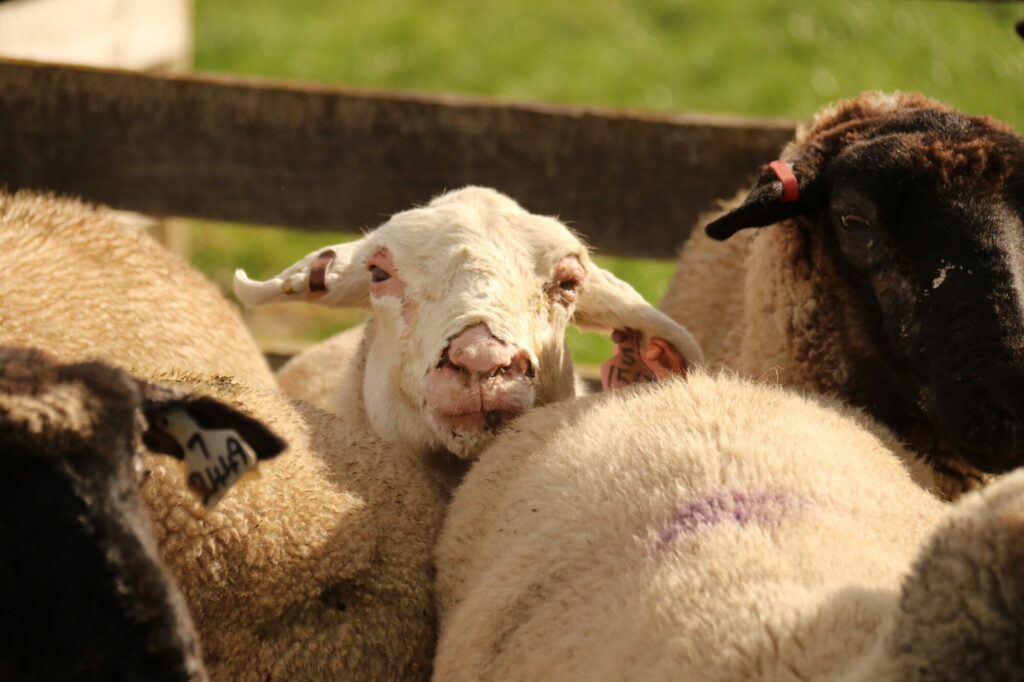
|  | |||||||||||
Collecting a pasture sample
|
 |
Facial Eczema Risk Monitor 2023
No results over 15,000 across the region this week (17-23 April).
Facial Eczema Spore count monitoring has now finished for the season. We would like to thank our monitor farms for collecting weekly samples and for their contribution to this data.
If you have any concerns or would like to continue monitoring the risk in your area please get in touch with your local clinic.
2023 Season Results from Waipukurau Monitor Farms

2023 Season Results from Hastings Monitor Farms
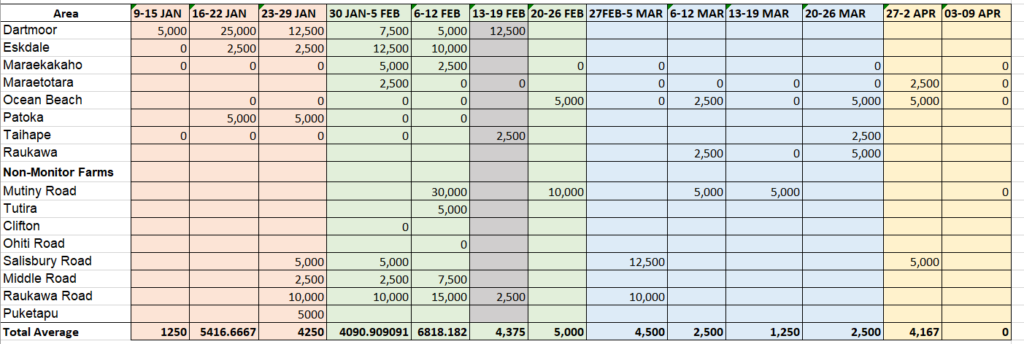
Facial Eczema Risk Monitor 2022
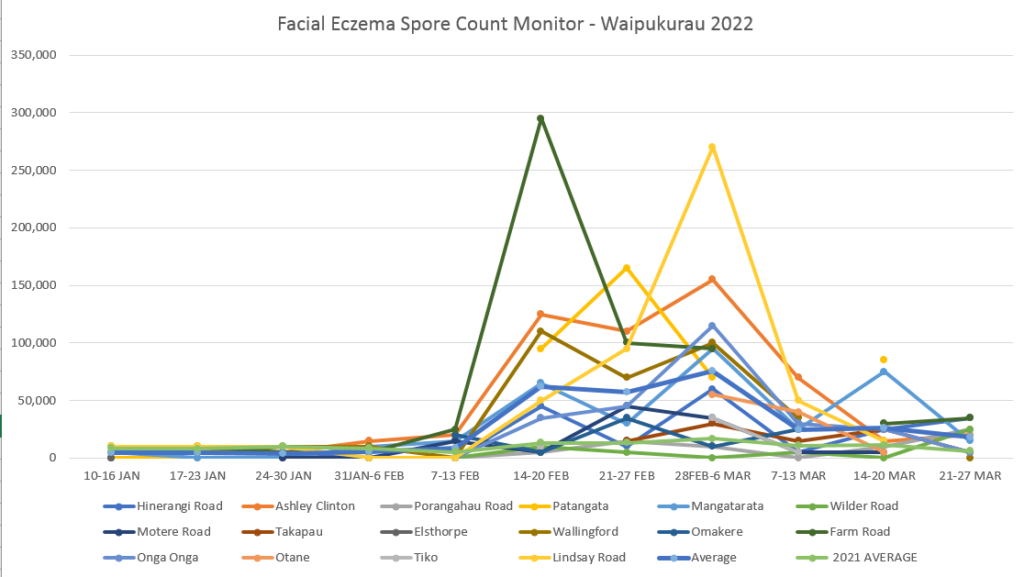
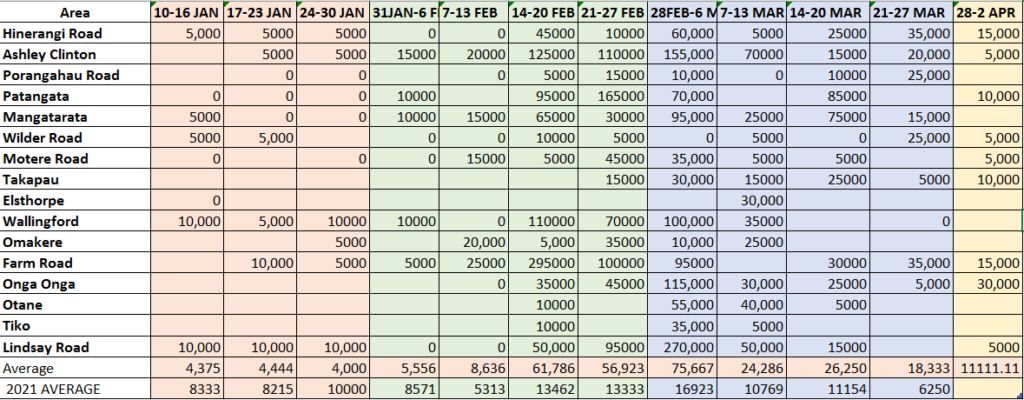
Hastings/Napier 13 Jan – 19 Jan 2025
Counts are low/moderate
Spore counts are low/moderate. The average count is sitting around 6071spg.
With the recent rain over the Christmas/New Year period and warm soil temperatures spore counts are expected to rise. We recommend you start monitoring paddocks that are ahead of rotation to reflect what stock may be going onto, especially North facing paddocks.
Hastings/Napier 13 Jan – 19 Jan 2025
Counts are low/moderate
Spore counts are low/moderate. The average count is sitting around 6071spg.
With the recent rain over the Christmas/New Year period and warm soil temperatures spore counts are expected to rise. We recommend you start monitoring paddocks that are ahead of rotation to reflect what stock may be going onto, especially North facing paddocks.
Hastings/Napier 27 Jan – 2 Feb 2025
Counts are low/moderate
Spore counts are low/moderate. The average count is sitting around 5000spg.
With the recent rain over the Christmas/New Year period and warm soil temperatures spore counts are expected to rise. We recommend you start monitoring paddocks that are ahead of rotation to reflect what stock may be going onto, especially North facing paddocks.
Hastings/Napier 10 Feb-16 Feb 2025
Spore Counts are moderate risk. The average count is sitting around 18,215 spg. Sporadic amounts of rain with some dewy mornings we are slowing starting to see an increase in spore counts in some areas of Hawkes Bay. We recommend you start monitoring paddocks that are ahead of rotation to reflect what stock may be going onto, especially North facing paddocks. And start looking into some possible preventative measures. If you would like to discuss options please give your nearest vet services clinic a call.
Action: Continue monitoring.
Waipukurau 4 – 9 March
Ashley Clinton is still our hot spot this week, with a spore count of 50,000/g. All other areas in the region are generally seeing low counts.
As we move into autumn, if these cooler mornings continue we should start to see a drop in soil temperatures and therefore a reduced survival of spores. However we still recommend monitoring any sheltered areas or paddocks of concern.
Keep an eye out on our website for the latest facial eczema results, and if you have any concerns please give our clinic a call.



